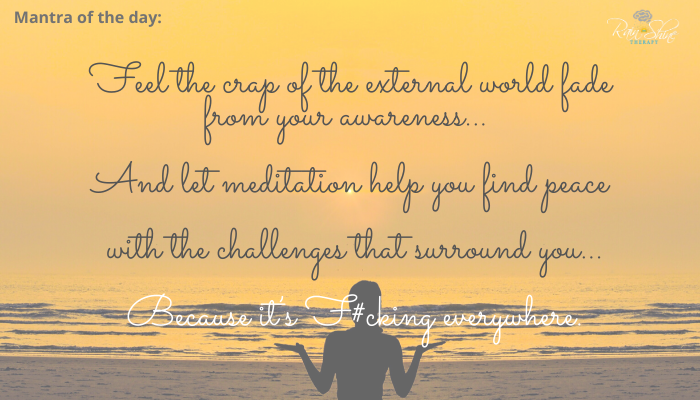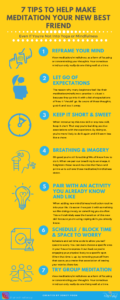
7 Tips to Help Make Meditation Your New Best Friend (Even if you’re not into yoga or mindfulness)
So, you tried meditating and reframing how you view mindfulness and meditation. (*Check out the last recent blog post as this is a continuation of that post).
Now you could use some tips on how to make it more effective or successful for you. Here are seven things to keep in mind if you feel like meditation just isn’t working for you:
1. Reframe your mind
View meditation/mindfulness as a form of focusing or concentrating your thoughts. Your conscious mind can only really do one thing well at a time.
2. Let go of all expectations
The reason why many beginners feel like their meditation/mindfulness practice is a bust is because they go into it with a list of expectations of how it “should” go. For example, if you think you should completely empty your mind when you sit down to meditate, you’re probably going to be frustrated when random thoughts are still popping up all over the place. Understand that when you relax your mind, it’ll naturally wonder more.
How about when I introduce it to my partner or kids, and they don’t feel anything? Remember, even if you’re practiced in it, they likely are not. So, prepare their minds that there are no expectations and if you would like, you can give them something to focus on like counting, their breath, the color on the wall, etc. You are helping them activate and exercise those parts of the brain they aren’t used to using. Lastly, don’t be disappointed by how they feel during their process, abandon all forms of judgement, and just observe and listen to what they find difficult. By allowing them to express that, it’s helping them tap into their internal awareness (perhaps even internal frustrations, negative energy) and externalize it. This is good, as it won’t be trapped inside their bodies.
3. Keep it Short & Sweet
When introducing this new skill or any new skill, keep it short. That way you’re building positive associations with the experience. By doing so, you’re more likely to do it again. Quit telling yourself that you “need”, “ought” “should” meditate or practice mindfulness for at least 30min a day, every day. When you do so, it becomes more of a chore than a desire.
4. Breathing & Imagery
We all know how to do this. When we pair our breathing to an image, it heightens those neural muscles that focus and prime us to achieve those meditative/mindfulness states. For instance, imagine you’re breathing in a color you like. For every intrusive thought or feelings, give them a color and breath it out. (This is easy to do for both adults & kids)
Science has shown that when we scan our brains while we’re imagining ourselves doing a certain activity, such as playing the piano, the same parts of the brain light up when we are physically engaged in doing it. Further studies have shown that through the power of imagery, participants who imagined they were playing a song versus the group who actually played the song were at 75% skill level compared to the other group. That is the power of our imagination and thoughts.
5. Pair with an activity you already know and like
When adding the new mindfulness/meditation routine into your life, it’s easier if we pair it with something we like doing already or something you do often. By doing so, we are hijacking some of the neural pathways we already formed to help us get there. So instead of just solely taking the dirt road to get to your destination, use a combination of dirt roads and highways. This will definitely ease the transition of this new skill because you’re using coping skills you already know.
For instance, if you like baking, try baking cookies and take deep breaths in while you wait for the cookies in the oven to be ready. Enjoy the delicious cookies, perhaps take notice of memories the smells evoke and talk about it. After all, smell is the world’s strongest memory trigger. This is an activity you can do with your children. The best part is the reward of eating the cookie after.
If you’re alone, you can choose to sit in front of the oven, feel the warmth it radiates as this will naturally relax your parasympathetic system. Then close your eyes, imagine yourself mixing the cookie ingredients. While you do so, choose to infuse emotions or thoughts you desire by labeling those ingredients with the following: happiness, resilience, strength, calm, etc. And when you’re ready to eat the cookies, imagine you’re infusing your body with those exact things you imagined during the meditative/mindfulness time.
Another example involves pairing it with a behavior your perform regularly. Take brushing your teeth for instance. Before you do so, take a couple of breaths and notice what you’re thinking of. If you find that challenging, you can use an app to help such as Headspace, Andy Puddicombe, Calm, etc. Start by setting it to 1min just before you brush your teeth. You’re more like to do it and practice it when you pair it with a behaviour you do regularly.
Lastly, as you’re physically brushing your teeth and spitting out the foam of toothpaste, imagine yourself letting go of some things that were bothering you during that breath work or app exercises prior.
6. Schedule/ block time & space to worry
No matter what advice you’re given or helpful tools you use, sort out your finances. I don’t care what the experts say or what you’re told you should do, when you’re worrying about finances, nothing else you do will help. By taking steps to sort out your finances you’re putting your worries into actions. (You’re taking control of your thoughts by embracing, processing and reframing your mind). This can be difficult and time-consuming, so block and set aside time specifically for this.
You can also do the same with your other worries. Schedule and set an alarm to allow yourself a specified time and space to worry. You can even choose a specific space in your house to express it out loud, so you’re engaging your physical body to a certain spot. When that time is up, by removing yourself from that space, you create that association of leaving it there too.
For children who are acting out, have outbursts, withdrawn, and feeling frustrated, you can help them set time to worry and allow them that space to express their thoughts and feelings. Create a physical space where they can do that, whether that is a special chair, a patch of grass or underneath a tree in the backyard, or even looking out into the neighborhood on the porch. By creating that time and space for your children, you’re getting them (including yourself) out of the beta waves (heightened state of conscious thought/worry) and into the alpha waves. As mentioned earlier, these are the same waves that are produced during mindfulness/meditation. Ultimately, you’re creating the necessary neural thought patterns to allow for meditation to be more effective and natural.
7. Try group meditation
It’s possible that meditation isn’t working for you because there is a lack of accountability and having trouble committing to the practice on your own. While mindfulness is more about your own solo internal reflection and activity, there is a certain motivation and energy we get from others, so trying out a group meditation session certainly will not hurt. Having peer support not only inspires you to stick to it, it can also help you feel not so alone while you’re learning what works best for you. If you and your support is willing to share your own experiences, you may even be surprised at what you may learn.
*If you want an accountability partner, please feel free to join the weekly Thursday sessions I host. Click on this link here to find out more: Find Your Peace Weekly
Please keep in mind that meditation and mindfulness practice is all about learning to focus (taking control of your thoughts and what to focus on) and to observe your thoughts without judgement. It’s simply about recognizing what’s going on up in your brain, delving into your internal selves and then letting it go. And hey, who knows, if you choose one or two of the above tips (start small!) to help you practice mindfulness and meditation on your own time at home, before long, you’ll find meditation will come to you naturally with total ease. So, stop trying to control every single aspect of your mindfulness practice and being so hard on yourself. With that in mind, you’ll be cruising along the mindfulness highway very soon.



